horse blanket guide
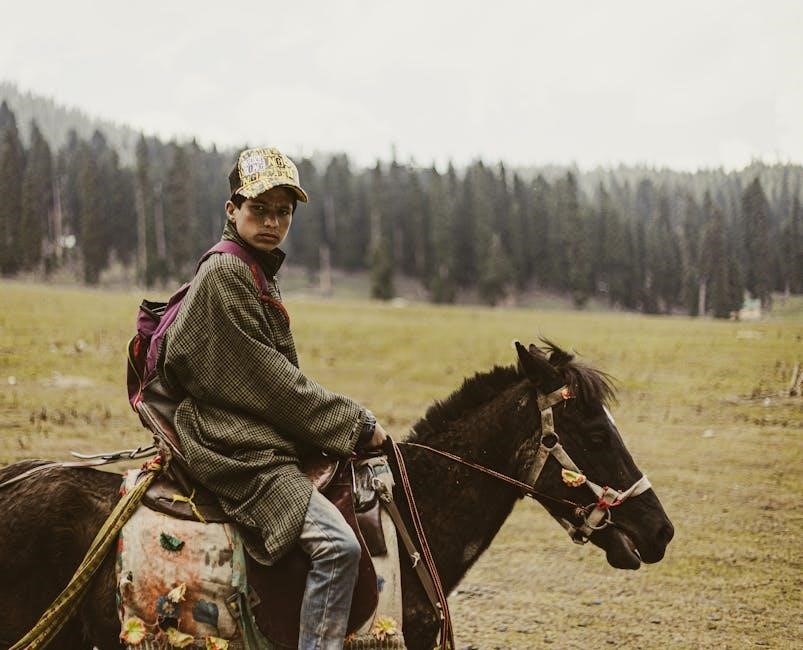
Horse blankets are essential for protecting horses from harsh weather, providing warmth and comfort. They come in various types and weights, catering to different climates, temperatures, and horse conditions. This guide will help you understand when and how to use them effectively.
1.1 What Are Horse Blankets?
Horse blankets are specially designed coverings used to protect horses from cold, wind, and rain. They are typically made of durable, water-resistant materials and come in various weights to suit different weather conditions. These blankets can be lightweight for milder days or heavyweight for extreme cold, ensuring your horse stays comfortable and warm. They are available in styles like turnout and stable blankets, catering to both outdoor and indoor use, and often feature fill for added insulation.
1.2 Importance of Using Horse Blankets
Horse blankets are crucial for protecting horses from harsh weather conditions, such as cold, wind, and rain. They help maintain the horse’s body temperature, preventing hypothermia and discomfort. Blankets also shield against moisture, reducing the risk of illness. For clipped horses, they are especially vital, as the lack of a natural coat makes them more vulnerable to cold. Using the right blanket ensures your horse stays healthy, comfortable, and stress-free, regardless of the season or weather. This makes them an essential part of equine care.
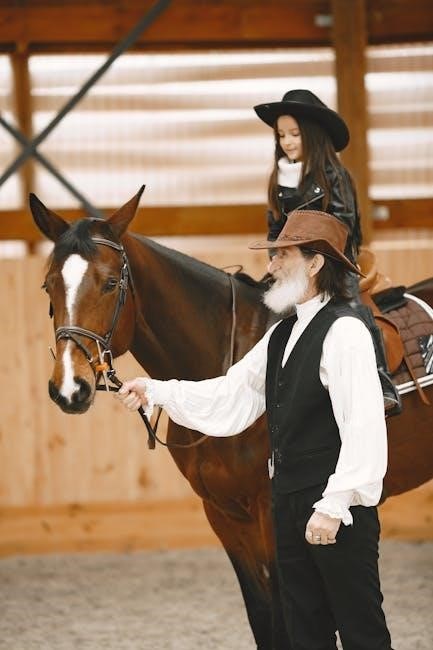
When to Blanket Your Horse
Determine when to blanket based on temperature, weather, and your horse’s condition. Blanketing helps maintain body heat and comfort during cold or harsh weather conditions.
2.1 Understanding Your Horse’s Needs
Understanding your horse’s needs is crucial for proper blanketing. Factors such as age, health, coat thickness, and whether they are clipped or unclipped influence their requirements. For instance, younger or older horses, or those with health issues, may need more warmth. Additionally, clipped horses generally require earlier and heavier blanketing compared to unclipped ones. Monitoring your horse’s behavior and physical condition helps ensure their comfort and well-being in varying weather conditions.
2.2 Temperature Guide for Blanketing
A temperature guide is essential for determining when to blanket your horse. Generally, horses may need a lightweight blanket when temperatures drop below 50°F (10°C) and a medium-weight blanket below 40°F (4°C). Heavyweight blankets are typically used when temperatures fall below 30°F (-1°C). However, factors like age, health, and whether the horse is clipped or unclipped can influence these thresholds. Always consider your horse’s individual needs and adjust blanketing accordingly to ensure comfort and prevent overheating.
2.3 Clipped vs. Unclipped Horses
Clipped horses require more frequent and heavier blanketing due to reduced natural insulation, while unclipped horses rely on their coats for warmth. Clipped horses may need blanketing at higher temperatures, typically above 50°F (10°C), depending on their health and environment. Unclipped horses can tolerate colder conditions but may still need protection in extreme cold or wet weather. Always consider the horse’s individual needs, as clipping significantly impacts their ability to regulate body heat. Use a temperature guide to determine the appropriate blanket weight for their specific situation.
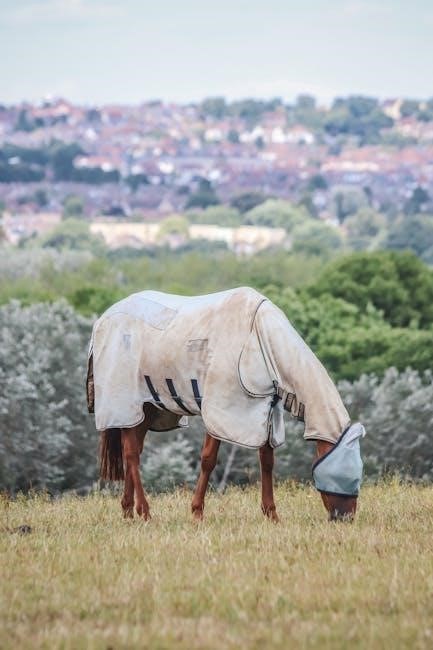
Types of Horse Blankets
Horse blankets come in lightweight, medium-weight, and heavyweight options. Turnout blankets are waterproof for outdoor use, while stable blankets are designed for indoor comfort and warmth.
3.1 Lightweight Blankets
Lightweight horse blankets are ideal for mild weather conditions. They provide minimal insulation without overwhelming the horse, making them perfect for spring or fall when temperatures are moderate. These blankets often lack fill, focusing instead on breathable materials to prevent overheating. They are a great option for clipped horses or those that live in regions with warmer climates. Lightweight blankets ensure comfort and protection without compromising mobility or natural thermoregulation. They are versatile and suitable for both stable and turnout use, offering a balance of coverage and airflow.
3.2 Medium-Weight Blankets
Medium-weight horse blankets are designed for cooler temperatures, typically between 40°F and 60°F. They offer balanced insulation, making them suitable for both clipped and unclipped horses during transitional seasons. These blankets are versatile, providing adequate warmth without being too heavy. They are ideal for horses that need protection from chill but do not require extreme warmth. Medium-weight blankets are a practical choice for everyday use, offering breathability and durability while keeping your horse comfortable in moderately cold conditions.
3.3 Heavyweight Blankets
Heavyweight horse blankets are designed for extreme cold weather, typically used when temperatures drop below 20°F for clipped horses or 15°F for unclipped ones. These blankets are densely filled, providing maximum insulation and warmth. They are ideal for older horses, those with health issues, or horses that struggle to stay warm. Made with durable materials, heavyweight blankets are perfect for harsh winter conditions. Always monitor your horse’s comfort to ensure they don’t overheat, as this can lead to discomfort or stress.
3.4 Turnout vs. Stable Blankets
Turnout and stable blankets cater to different needs. Turnout blankets are waterproof and designed for outdoor use, protecting horses from rain and wind. They are breathable and durable, making them ideal for horses living in paddocks. Stable blankets, on the other hand, are used indoors and focus on providing warmth without waterproofing. They are often softer and designed for comfort in a dry environment. Choosing the right type depends on your horse’s living situation and climate conditions.
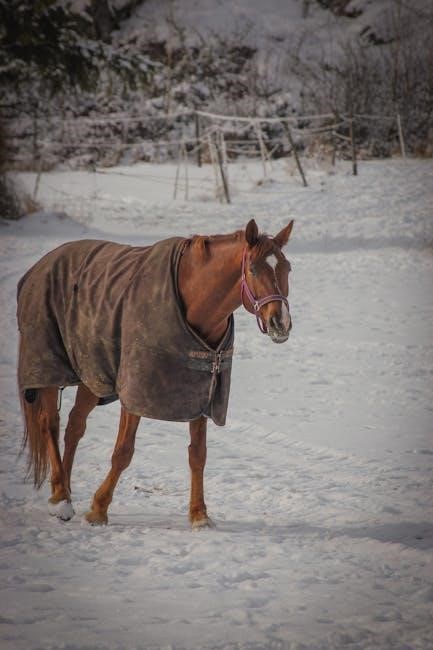
Factors to Consider When Choosing a Blanket
When selecting a horse blanket, consider your horse’s specific needs, climate, and living conditions. Factors include weight, fit, material, durability, and purpose (outdoor or indoor use).
4.1 Weight and Fill
The weight and fill of a horse blanket determine its insulating ability. Lightweight blankets (0-150g) suit mild weather, while medium-weight (150-300g) and heavyweight (300g+) options are for colder conditions. Fill material, such as polyester or down, affects warmth retention. Choose based on your horse’s needs, climate, and whether they are clipped or unclipped. Proper weight ensures comfort and prevents overheating or chilling. Always consult a temperature guide to select the appropriate blanket for optimal warmth and health.
4.2 Fit and Sizing
Proper fit and sizing are crucial for your horse’s comfort and safety. A well-fitted blanket prevents rubbing, chafing, and restricted movement. Measure your horse from the center of the chest to the edge of the hindquarters to determine the correct size. Ensure the blanket lies flat and isn’t too tight or loose. Regularly check the fit, as your horse’s size may change with age or condition. A poor fit can lead to discomfort or health issues, so choose a blanket that accommodates their natural movement and body type;
4.3 Material and Durability
The material and durability of a horse blanket are vital for its performance and longevity. Look for high-quality fabrics like nylon, polyester, or canvas, which offer strength and water resistance. Waterproof coatings are essential for turnout blankets to withstand rain and snow. Durable stitching and reinforced seams ensure the blanket can endure rough use. Breathable materials, such as cotton or fleece, help regulate body temperature and prevent overheating. Investing in a well-made blanket ensures comfort, protection, and extended use, making it a worthwhile purchase for your horse’s well-being.
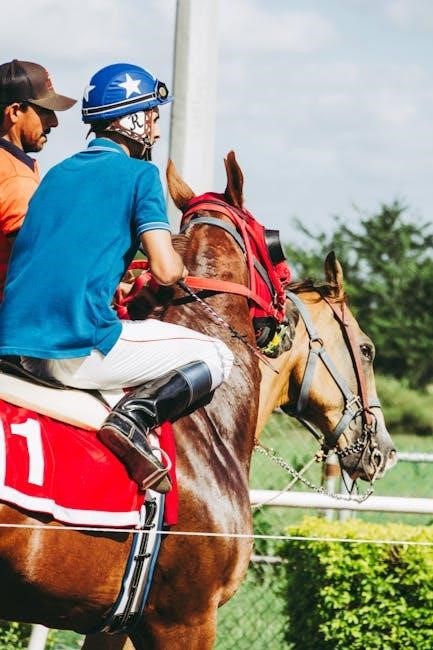
Climate and Weather Considerations
Climate and weather significantly influence horse blanketing. Temperature, moisture, and wind determine the need for lightweight, medium, or heavyweight blankets. Always consider regional climate patterns.
5.1 Blanketing in Cold Weather
Blanketing in cold weather is crucial to protect horses from hypothermia and discomfort. The choice of blanket weight depends on temperature and whether the horse is clipped or unclipped. Materials like polyester and wool offer durability and warmth. Ensure proper fit to prevent rubbing and restricted movement. Monitor your horse’s comfort, adjusting blankets as temperatures fluctuate. Layering with a liner can provide extra warmth during extreme cold snaps. Always prioritize breathability to avoid overheating, especially in active horses.
5.2 Blanketing in Wet or Windy Conditions
Blanketing in wet or windy conditions requires careful consideration to keep your horse dry and comfortable. Waterproof turnout blankets are ideal for rainy or windy weather, as they repel moisture and prevent chilling. Look for breathable materials to avoid trapping condensation, which can cause discomfort. Ensure a snug fit to prevent wind from penetrating the blanket. Regularly check and adjust the blanket to avoid rubbing or shifting. Proper layering and fit are essential to protect your horse from harsh weather conditions effectively;
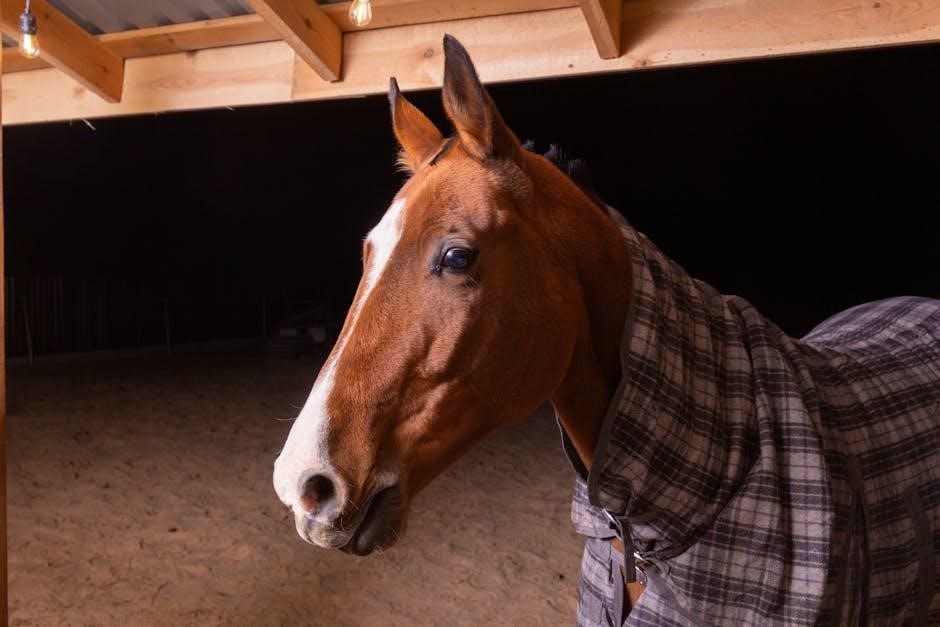
5.3 Layering Blankets for Extreme Cold
Layering blankets is a practical approach for extreme cold. Start with a lightweight liner to trap warmth, then add a medium-weight blanket for additional insulation. Finally, use a heavyweight or waterproof blanket as the outer layer. This method allows you to adjust your horse’s coverage based on temperature fluctuations. Ensure each layer fits properly to avoid discomfort or restricted movement. Regular checks are crucial to prevent overheating and ensure your horse remains comfortable and protected from the cold weather conditions.
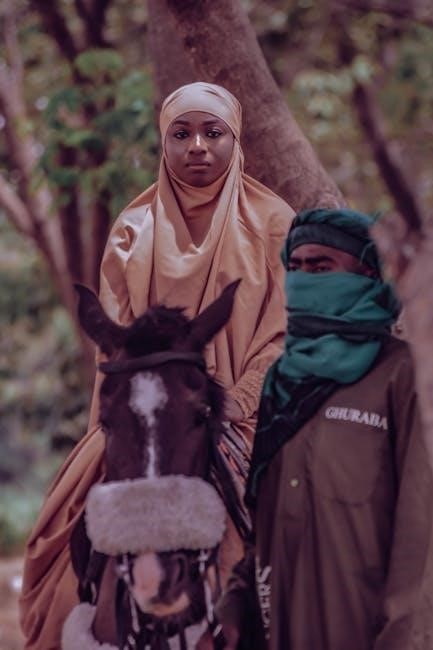
Caring for Horse Blankets
Regular cleaning, proper storage, and inspections are vital for maintaining horse blankets. Cleanliness prevents skin irritation, while storage keeps them dry and ready for use. Inspect for damage to ensure durability and effectiveness in protecting your horse.
6.1 Washing and Cleaning Tips
Washing horse blankets regularly is crucial to prevent dirt buildup and odor. Use mild detergents and cold water to avoid damaging materials. Avoid harsh chemicals or bleach, as they can weaken fabrics or irritate your horse’s skin. For tough stains, spot clean before washing. Air dry blankets to prevent shrinkage and maintain their shape. Regular cleaning ensures your horse stays comfortable and healthy, while extending the blanket’s lifespan.
6.2 Storing Blankets Properly
Store horse blankets in a clean, dry, and rodent-free area to prevent damage. Ensure blankets are completely dry before storing to avoid mold and mildew. Fold or hang them neatly to maintain shape and prevent creasing. Avoid storing in direct sunlight or humid environments. Regularly inspect stored blankets for signs of wear or pests. Proper storage extends the lifespan of blankets and keeps them ready for use when needed.
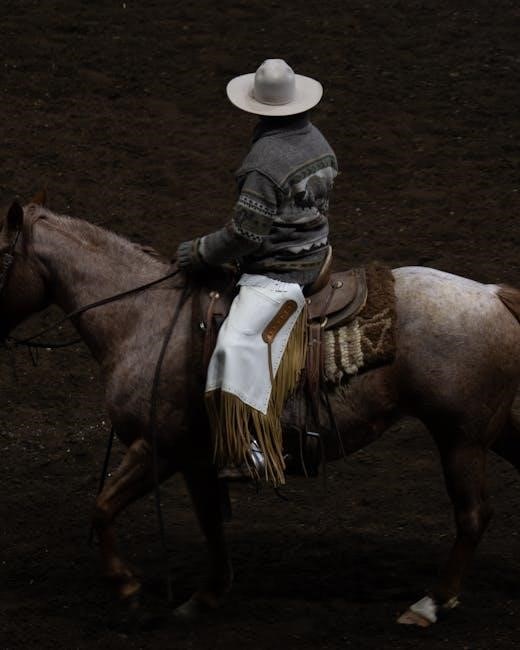
Health Considerations
Monitor your horse’s health and comfort to ensure proper blanketing. Factors like weight, age, and medical conditions can influence their needs, preventing discomfort or stress.
7.1 Monitoring Your Horse’s Comfort
Regularly check your horse for signs of discomfort, such as sweating, shivering, or restlessness. Adjust blankets based on temperature changes and your horse’s behavior to ensure proper warmth and prevent overheating. Clipped horses may need closer monitoring, especially in colder conditions.
Observe your horse’s posture and movement; stiffness or reluctance to move can indicate issues. Remove or replace blankets if you notice discomfort or stress. Consistent observation helps maintain their well-being and ensures the blanket is serving its purpose effectively.
7.2 Signs Your Horse Needs a Blanket
If your horse is shivering, has a clipped coat, or appears uncomfortable in cold weather, it likely needs a blanket.
Monitor for signs like huddling, lack of energy, or difficulty staying warm. Elderly or thin horses may require blankets earlier in the season.
Always consider temperature and your horse’s condition; a blanket can provide necessary warmth and prevent health issues during colder months.

Common Mistakes to Avoid
Over- or under-blanketing can cause discomfort or health issues.
Ignoring proper fit, failing to monitor temperature, and over-layering are frequent errors.
8.1 Over- or Under-Blanketing
Over-blanketing can lead to overheating, sweating, and discomfort, while under-blanketing may leave your horse too cold. Both scenarios can cause stress and health issues. Monitor your horse’s behavior and adjust blankets according to weather changes and individual needs. Avoid using too many layers, as this can restrict movement and trap excess heat. Always consider your horse’s age, health, and whether they are clipped or unclipped. Proper observation and adjustment are key to ensuring comfort and well-being.
8.2 Ignoring Fit and Sizing
Ignoring proper fit and sizing can lead to discomfort, rubbing, and restricted movement. A blanket that’s too tight or too loose may cause skin irritation or fail to provide adequate coverage. Ensure the blanket fits your horse’s body shape and size, allowing for natural movement. Always check the fit by placing the blanket on your horse and adjusting as needed. Proper sizing is crucial for your horse’s comfort and to prevent potential health issues. A well-fitted blanket supports overall well-being and performance.

Expert Tips for Blanketing
Layering blankets for versatility and using a liner can enhance comfort. Monitor your horse’s condition to ensure optimal warmth without overloading, keeping them comfortable in all conditions.
9.1 Layering for Versatility
Layering horse blankets offers flexibility, allowing you to adjust your horse’s coverage based on weather conditions. Start with a lightweight liner to wick moisture, then add a mid-weight blanket for moderate cold, and finish with a heavyweight or turnout blanket for extreme temperatures. This approach ensures your horse stays comfortable without overheating or underheating, adapting seamlessly to changing environments and activity levels.
9.2 Using a Blanket Liner
A blanket liner is a lightweight layer designed to wick moisture and add versatility to your horse’s blanketing system. It helps prevent overheating and can be used alone in mild weather or layered under heavier blankets in colder conditions. This adaptability ensures your horse remains comfortable across varying temperatures and activities. Additionally, using a liner can extend the life of your horse’s blankets by reducing wear and tear, making it a practical and efficient choice for horse care.
Proper horse blanketing is essential for their comfort and health, ensuring they stay warm and protected in various weather conditions while maintaining their well-being year-round.
10.1 Final Thoughts on Horse Blanketing
10.2 Best Practices for Horse Care
Effective horse care involves a combination of proper blanketing, regular grooming, and a balanced diet. Always monitor your horse’s health and adjust care routines according to seasonal changes. Ensure blankets fit well to prevent discomfort or injury. Provide adequate shelter and fresh water year-round. Regular veterinary check-ups and dental care are also essential for maintaining overall well-being. By following these best practices, you can help ensure your horse remains healthy, comfortable, and thriving in all conditions.